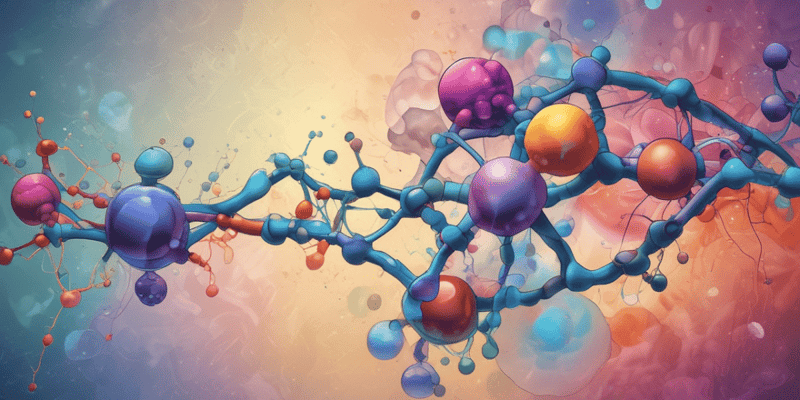Questions and Answers
Quel est le rôle des bases azotées dans les nucléotides?
Transmission de l'information génétique
Quel est l'effet de la présence d'azote dans les bases guanine et cytosine?
Formation de liaisons hydrogène stables
Comment la guanine se lie-t-elle dans l'ADN?
Avec la cytosine
Quel est le rôle de l'azote dans la formation des liaisons entre les bases?
Signup and view all the answers
Quelle base azotée forme une paire unique avec l'uracile dans l'ARN?
Signup and view all the answers
Combien de liaisons hydrogène forment la guanine avec la cytosine?
Signup and view all the answers
Quel est le rôle de l'azote dans le maintien de la force des liaisons hydrogène entre les bases azotées dans l'ADN?
Signup and view all the answers
Quelle base azotée ne contient pas d'azote dans sa structure?
Signup and view all the answers
Quel type de liaisons la cytosine forme-t-elle avec la guanine dans l'ADN?
Signup and view all the answers
Comment l'adénine interagit-elle avec l'uracile dans l'ARN?
Signup and view all the answers
Quelle caractéristique distingue l'adénine des autres bases azotées?
Signup and view all the answers
Pourquoi la thymine ne peut-elle pas participer aux appariements de bases par liaisons hydrogène traditionnelles dans l'ADN?
Signup and view all the answers
Study Notes
Nitrogen Bases in Nucleotides
Nucleic acids, specifically DNA and RNA, consist of building blocks called nucleotides. These molecules play crucial roles in storing and transmitting genetic information throughout living organisms. Each nucleotide is composed of three components: a sugar molecule, a phosphate group, and one of four different types of chemical groups known as bases. These bases are responsible for carrying out essential processes within cells by forming complementary pairs when they connect during the synthesis of DNA strands; this pairing occurs via hydrogen bonding between specific base partners. This interaction allows for accurate replication and transcription of genetic material from cell to cell. Let's delve into more detail regarding these nitrogenous bases present in nucleotides—guanine, cytosine, adenine, and thymine.
Guanine
Guanine contains five carbon atoms, two nitrogens, three oxygens, and three hydrogens. It has a double ring structure consisting of one purine ring connected to another ring comprising only carbon and oxygen. In DNA, guanine always pairs up with cytosine through three hydrogen bonds. However, in RNA, it forms a unique pair with uracil, which lacks a nitrogen atom (see below). The presence of nitrogen in both guanine and cytosine supports their ability to form strong, stable hydrogen bonds, ensuring the accuracy of genetic transfer.
Cytosine
Cytosine is very similar to guanine, also containing a double ring structure but with one less nitrogen atom compared to its counterpart. It consists of six carbons, two nitrogens, two oxygens, and four hydrogens. When paired with guanine in DNA, cytosine forms three hydrogen bonds. In RNA, cytosine pairs with uracil instead, creating essentially mirror images of DNA's G-C and A-U pairs. Again, the role of nitrogen in maintaining hydrogen bond strength ensures the integrity of genetic code transmission.
Adenine
Adenine differs significantly from guanine and cytosine; while it retains a purine ring like them, it does so without any attached oxygen rings. Instead, there are two additional amino groups located where the oxygen atoms would usually be found on other nitrogenous bases. Like guanine, adenine interacts with thymine in DNA through two hydrogen bonds. But unlike its counterparts, it creates a new type of pair when found in RNA, binding to uracil—this time through two hydrogen bonds. Once again, the crucial involvement of nitrogen in facilitating proper hydrogen bonding is evident.
Thymine
Thymine is notable because it does not contain nitrogen anywhere in its structure. Unlike the others, it possesses no aromaticity due to its single ring system comprised solely of carbon, nitrogen, and sulfur atoms. Because of this, it cannot participate in traditional hydrogen-bonded base pairing seen among DNA nucleobases. Consequently, it must adapt for function within DNA structures, forming weak van der Waals interactions with adenine. Similarly, in RNA, thymine replaces uracil as an alternative pair to adenine. Although lacking the classic 'nitrogenous base' traits, thymine still plays a vital role in preserving DNA stability by mediating nontraditional interactions.
In summary, nitrogenous bases are central actors in the world of nucleic acid chemistry, primarily due to their capacity to engage in multiple and highly selective hydrogen bonding patterns. Their structural differences reflect variations in base pairing dynamics that ultimately shape how genetic material is encoded and processed across lifeforms.
Studying That Suits You
Use AI to generate personalized quizzes and flashcards to suit your learning preferences.
Description
Explorez les bases azotées clés - guanine, cytosine, adénine et thymine - qui composent les nucléotides et jouent un rôle crucial dans le stockage et la transmission de l'information génétique. Découvrez comment ces bases interagissent pour former des appariements complémentaires via des liaisons hydrogène, assurant ainsi l'exactitude de la réplication et de la transcription de l'ADN. Comprenez l'importance des différences structurales entre ces bases pour la stabilité et l'intégrité du matériel génétique.




